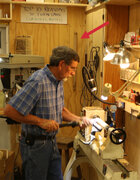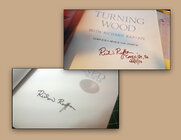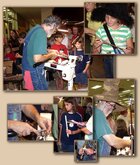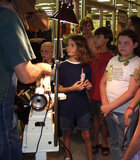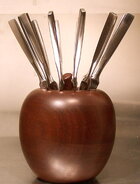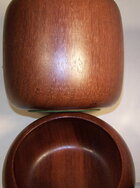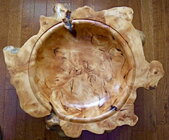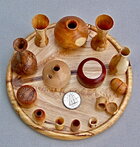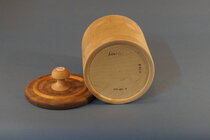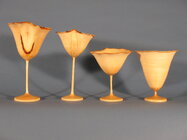I've spent some time hearing about people on the forum, and I keep hearing people say they worked at a school, or teach, or have students. I also hear that some have 20+ chucks or a lot of lathes. I know to some degree that if you are doing this awhile you have probably collected a lot, but some of what I hear seems a little extreme to my newbie ears. My question is, during your time as a woodturner/woodworker, have/do you taught? Was it at a school, public or private, was it a college/university, was it a private class for woodturners?
I started teaching after I got my first lathe, very soon after I got my first USEFUL lathe. I was a complete beginner but primarily learned from books and loved it. My first two student were my son and his friend. This was well nearly 25 years ago. We later bought a farm and I built a 24x62' shop with climate control down near the barn - makes playing year around more fun! And with the woods full of trees, sawmill, and equipment to move logs, there is plenty to work with.
Since then I've taught dozens of beginners in my shop, usually individuals or in groups of no more than two since I usually have two lathes in the shop. I love it. I've also done demos in various clubs in TN and several surrounding states, and assisted in a course and taught a private course a couple of major crafts schools. I far prefer one person at a time so I my attention can be focused on how best to help them. I've turned down classes of beginners since my attention would be so divided everyone would suffer. (A class of 8 beginners needs at least 4 experienced teachers, IMO.)
My passion is to introduce people to the lathe, show them some examples of things I can make, let them see what it's how the wood spins and the tools are used. Some call and just want something made so I get them to come watch and help a bit, depending on their age and interest. Some may never touch a lathe again - that's OK, now they know what it's about.
Many students come for multiple lessons, some for a year or more. My method of teaching is different from most - I never start with bowls or pens. I mount a smoothly rounded cylinder of maple on the lathe, maybe 12"x2", give initial instruction on tool placement, hand them a shaving-sharp 1" skew chisel, and turn the lathe by hand. I watch every move, correcting tool presentation, angles, arm/leg movement, until they can consistently make delicate shavings down the cylinder. This takes surprisingly little time, 5-15 minutes for most people. When they conquer the shavings, I turn the lathe on the slowest speed and they practice planing cuts, then inch up the speed - in a very short time they are planing with the skew at high speed (it's actually easier that way). Next, I teach v-grooves with the skew, start on coves with the spindle gouge, then eventually get to the spindle roughing gouge and other tools. Each does a practice stick covered with beads and coves at the first lesson. I have NEVER had a student get a catch with the skew.
The reason I start with spindles is it's been shown that spindle turning will teach the fine tool control needed to turn ANYTHING. I have references.
When asked my fee, I tell them "a good story or a good joke". I never accept payment. When someone suggested, I did put have a tip jar when I taught 4-hour bandsaw classes in my shop on how to prepare and dry useful turning blanks from log sections - helped pay for new blades. In general, I don't sell things either but give them away - although I have accidentally made a few thousand$ here and there, sometimes with some arm twisting. If I turned to sell it would be like having a 2nd job which I don't want or need. I teach because I love it.
I've turned plenty of wet wood but I far prefer the advantages of dry wood so that's what I teach. After some introductory lessons we learn to make a variety of things from dry wood - spindles, goblets, bowls, ring keepers, lidded boxes, platters - following their interests. The biggest problem with turning dry over green is availability since green wood is free and dry wood usually costs money. Also, I find turning bowls from green wood, while fun and easy, doesn't provide much challenge. That's one reason I've taught classes on how to cut log sections into turning blanks and dry them. (I've posted a video here on that, one I did for a pandemic zoom demo)
Some examples of a few students at the lathe (I've shown these photos here before):
The two girls in the top center and right were vet students who came to the farm often for the animals. I offered them a lathe lesson - in the morning they learned the skew and spindle gouge and both made things to take home. After lunch I taught the bowl gouge and they did a little practice bowl from cedar then both took home respectable cherry bowls. Good clean fun! One is now a practicing vet, has a lathe and turns often. The other is hard at work on her PHD in pathology and perhaps will play with wood again when she gets some time. The girl in the upper left visited from Italy and took home a beautiful ring keeper.
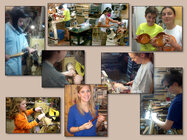
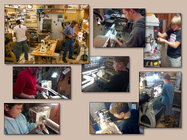
I sometimes have very young students, 8-10 years old. In this case, they may do no significant turning but help with pencil lines marking the wood, gentle sanding, and applying finish. I built a platform for short people. Many kids come with their parents. They have all loved it! Some have been old turners who came for remedial skew lessons or to learn to make something special.
I've turned many things but I think I love teaching as much or more than making things. Perhaps it's a deep desire to share and add a tiny bit of something new to another's life. I taught kindergarten SS classes every week for 27 years, large groups of 50 or so kids, some piano and guitar, wood and pumpkin carving, llama/horse care, cleaning stalls, gardening, caring for baby peacocks, even how to clean and prepare a chicken for the freezer - many kids have NO idea of where their food comes from. ("Where are the nuggets on a chicken?") A couple of young boys came for a day who had never before walked on grass or on a trail through the woods! Teens may get to drive the tractor, 4-wheelers, even the excavator or something. They all go home with a new life experience.
I know several others who also love to teach woodturning. The mentoring program in our club is a big help since it provides contacts and insurance. I am slowing down a bit now with health and age (75) but still teach in the shop and do club demos.
To me there is no joy like helping put a smile on someone's face!
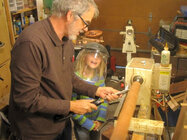
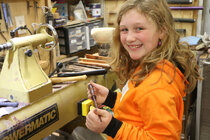
JKJ





